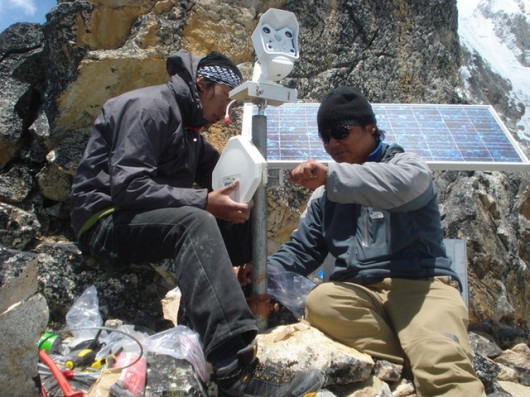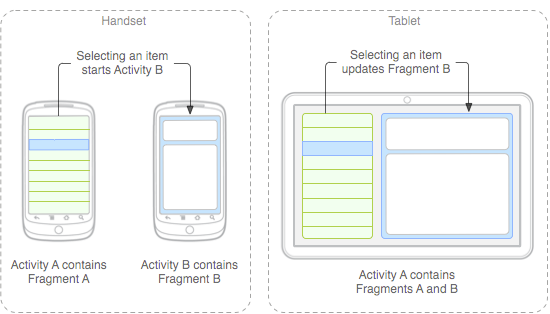Friday, September 30. 2011
Researchers install world’s highest webcam to provide a view of Everest
Via gizmag
-----
After starting out producing security cameras, German-based Mobotix is now taking video surveillance to new heights - literally. One of the company's type-M12 cameras has been situated at an altitude of 5,643-meters (18,514 ft) on the Kala Patthar mountain to stream high definition images of the summit of the nearby 8,848-meter (29,029 ft) high Mount Everest. The solar-powered webcam takes the title of the world's highest webcam from the now second highest webcam in the world located at the 4,389-meter (14,400 ft) high base camp of Mount Aconcagua in Argentina.
The Kala Patthar location, which was chosen for its excellent view of the western side of Everest, including the north and southwest faces of the mountain and the West Ridge, exposes the webcam to some pretty harsh conditions with high winds and temperatures as low as -30°C (-22°F). Images captured by the webcam are transmitted wirelessly to the Ev-K2-CNR Pyramid Laboratory/Observatory, which is located at an altitude of 5,050 meters (16,568 ft). Here, the video is analyzed before being sent onto Italy for further evaluation.
"We spent months developing the perfect setup for the installation and invested a lot of time testing and verifying the system. And it inspired us on to set a record: operating the highest webcam in the world," said Giampietro Kohl, leader of the Ev-K2-CNR technical committee who coordinated the webcam's installation by Italian engineers and the Nepalese Ev-K2-CNR team as part of the "Everest Share 2011" research project,
The research project is taking place as part of the international "Share" climate and environmental monitoring conference, with researchers hoping the images, in conjunction with meteorological data gathered at the world's highest weather station sitting at an altitude of 8,000 meters (26,247 ft) on Mount Everest, will provide an insight into climate change.
People can take in the view provided by the Mobotix webcam from the comfort of their homes by pointing their browsers here. The webcam is only active during the daylight hours of 6:00 a.m. to 6:00 p.m. Nepalese time, with images updated every five minutes to allow the researchers to track the movement of the clouds around the mountain summit. If you'd like to turn the view around and see what it looks like from the summit of Everest, there's also a nice 360-degree panorama here.
Thursday, September 29. 2011
Wi-Fi networks could detect your breathing and pinpoint your location
Via dvice
-----
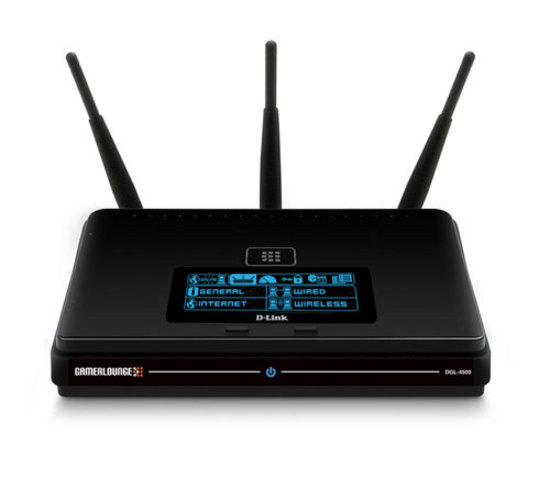
Well, this is a little unsettling: it turns out that Wi-Fi signals are slightly affected by people breathing, and with the right tech someone could pinpoint where you are in a room from afar using just Wi-Fi.
This was discovered when University of Utah researcher Neal Patwari was looking for a way to monitor breathing without using uncomfortable equipment. If you can track breathing using just a Wi-Fi signal, it'll make sleep studies easier for both researchers and subjects. And it worked! By laying in a hospital bed surrounded by a bunch of wireless routers, they were able to accurately estimate his breathing rate within 0.4 breaths per minute.
Now that this is known, it's only a matter of time until there's a way to detect people in rooms using Wi-Fi signals. But don't worry! If you're nervous, there's a simple solution: stop breathing.
-----
Wednesday, September 28. 2011
This is why you'll want a 3D printer for Christmas
Via dvice
-----

MakerBot's Thing-O-Matic 3D is a toy-printing badass.
Robot Santa's going to be busy this year. With all the shiny new gadgets he needs to deliver, his elves will have it hard. You want one toy? Pfft. What you want is a whole elf workshop of your own — a place that pumps out unlimited amounts of toys — or at least, something similar. That's a 3D printer.
The ultimate present this year is a 3D printer — a machine that makes, err, "prints" toys. Who needs to keep asking for gifts from people, when you can print some new ones whenever you want to?
We've already rounded up the six most affordable 3D printers you can buy right now, but here's a taste of the printers in action, because photos can only excite you so much.
New DoCoMo smartphone case able to detect radiation
Via Asahi shimbun
-----
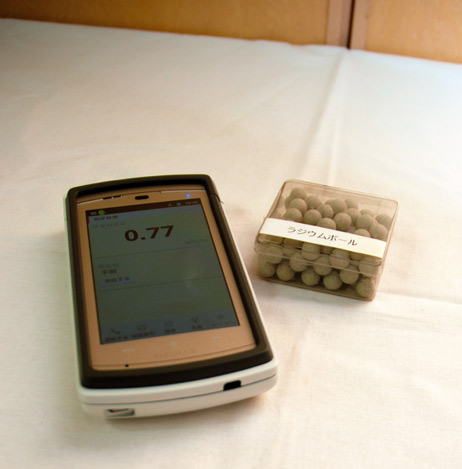
NTT DoCoMo Inc. has developed a smartphone case featuring a function that measures radiation levels.
The case has a sensor on it that identifies radiation levels, and the results show up on the screen. A special application must be installed to take advantage of the service.
The new feature, using technologies developed by a domestic dosimeter maker, can determine radiation levels from 0.01 microsieverts to 100 millisieverts per hour, the company said. The device also allows people to access measured values by time on a map using the global positioning system available with the carrier's smartphones.
NTT DoCoMo also developed smartphone cases that enable measurements of ultraviolet rays and body fat percentages. These cases can be switched to monitor various health conditions, the company said. Specific dates for marketing the cases have yet to be decided.
Prototypes of the three cases will be exhibited at Ceatec Japan 2011, Japan's largest exhibition on IT and electronics, to be held Oct. 4-8 at the Makuhari Messe convention center in Chiba Prefecture.
Tuesday, September 27. 2011
Facebook and the 'Like Me’ Election
Via Businessweek
By Elizabeth Dwoskin
-----
New advertising tools from the social media giant let campaigns find and target voters

Charlie Neibergall/AP Photo
Michele Bachmann wants to be your friend. So much so that her campaign is scouring your travels on Facebook for the things that matter to you most. Then she can place a customized message on your page assuring you that those things are important to her, too.
Bachmann did this to great effect in August, when she won the Republican straw poll in Iowa in part by zeroing in on the Facebook pages of potential supporters who lived nearby. Facebookers who had identified themselves as Tea Party supporters or Christian rock fans, or who had posted messages in favor of tax cuts or against abortion, found an ad from Bachmann waiting for them on their profile page in the weeks before the vote, asking for their support and directing them to a link where they could arrange a free ride to the polling place. Bachmann’s campaign says a significant portion of the people who pushed her over the top in Iowa—they won’t say how many—came as a result of the ad campaign.
While some candidates are still trying to get their heads around social media —Rick Perry has been known to block people he doesn’t like from following him on Twitter—Bachmann and other well-funded candidates, including Mitt Romney and Barack Obama, are putting Facebook at the center of their campaign strategies. Working with Facebook’s Washington office, they are taking advantage of just-released advertising tools the company is marketing to politicians.
The software allows candidates to target campaign ads to individuals in ways that weren’t possible a few months ago, reaching them on a site where they spend a lot of time and are less likely to tune out the pitch. “They may not know we’re looking for them,” says Rebecca Donatelli of Campaign Solutions, a social media consulting firm in Alexandria, Va., which was hired by Bachmann. “So we have to give them the opportunity to be found.”
Unlike expensive radio and TV ads, which are blasted out to thousands or millions of people and hit the eyes and ears of as many opponents as supporters, these appeals are often aimed at just a few hundred or even a few dozen potential voters who may never have expressed interest in the candidate. The ads use information Facebook constantly collects about its users to connect with people. “In the last 45 days, I’ve designed over 1,000 ads,” says Michael Beach, a GOP consultant working for Romney.
The campaigns are able to churn out so many ads because Facebook makes it cheap and easy to do, especially compared with TV spots or even Google (GOOG) Ads, which can reach many more people but not necessarily the ones most likely to respond favorably. Facebook ads can be had for 50¢ or less per click—and by counting those clicks, the campaigns know within minutes whether they’re working.
“We’ll throw out four or five different messages targeting different demographics,” says Michael Hendrix, a Dallas-based consultant who works with Donatelli on the Bachmann campaign. “You’re trying to figure out which message will drive a higher response.”
Hendrix’s latest Facebook project is what he refers to as “the gamification of politics.” In virtual reality games such as Facebook’s popular FarmVille, he sees a demographic frontier for Republicans in 2012. He has written software, to be launched later this year, that will allow FarmVille players to get active in politics within the game. Their online characters will be able to go door to door to other players’ imaginary farms, campaigning for real-life candidates and placing yard signs on their lawns. Hendrix is blunt about his intentions. “The majority of social gamers are stay-at-home moms over 38,” says Hendrix. And they vote. He hopes to use the game “to target soccer moms again.”
Facebook’s voter-sifting tools are the same as those it markets to corporations. (Sometimes the same people use the tools for politics and commerce; in addition to his work for Bachmann, Hendrix handles social media for Moët Hennessy (LVMUY), the Champagne maker.) But the pitch is different. The company has stocked its Washington operation with political pros who speak the language of campaigns and elections.
In 2007, Facebook hired Adam Conner, then a 23-year-old Democrat staffer on the House Rules Committee, to help the company break into the capital. He started out slow, teaching politicians the basics of setting up a Facebook page. Democratic politicians were happy to hear Conner’s social media spiel, but some Republicans viewed him with suspicion. So in February, Facebook hired Katie Harbath, a 30-year-old digital strategist for the National Republican Senatorial Committee. Around the office, they’re jokingly known as “the R” and “the D.”
Facebook’s post-industrial space in downtown D.C., where guests are invited to write on the walls with brightly colored Sharpies, may be the most un-Washington workplace in the city. “What I push with folks is that, while the fan count matters, how many people are interacting with it really matters,” says Harbath, who is one of a dozen people working for Facebook in Washington. “How many people are liking it, commenting on it, sharing it with their friends.”
Which raises an important question: Is the effort and money Bachmann and her rivals put into all this liking, commenting, and sharing bringing tangible results that can be measured in volunteers, donations, and ultimately votes next November? The answer is: They don’t know yet. No one has figured out how to “monetize the like,” says Donatelli. What Facebook provides at the moment is an efficient way to reach someone without having to reach everyone and an enormous platform to get a message across without interference from the conventional media. “It’s not in the sheer numbers, but in the intensity of your followers,” Donatelli says. She says that Bachmann fans tend to be issue-driven and feverishly post and cross-post on Facebook, keeping the candidate’s name in the conversation even as her poll numbers slide compared with Romney’s and Perry’s.
Ultimately, Bachmann’s team believes conversation will translate into action and money, like they say it did in Iowa this summer. Otherwise, they say, they wouldn’t bother wasting precious resources on it. “What’s the point of having a fan or a follower if they don’t do anything?” says Donatelli. “At the end of the day, this is a persuasion tool.”
The bottom line: Presidential candidates are targeting potential supporters with Facebook ads, which can cost less than 50¢ a click.
Monday, September 26. 2011
Google digitizes the Dead Sea Scrolls and puts them online
Via Slash Gear
-----
The Dead Sea Scrolls are some of the most famous Christian documents in the world and they are the oldest known biblical manuscripts in existence. The scrolls have a storied history that saw them stashed away inside a series of caves on the shores of the Dead Sea to protect them for the Roman armies that were invading the Holy Land in 68 BCE. The scrolls were lost until 1947 when a shepherd tossed a rock into the cave and discovered the scrolls.

The scrolls have been on exhibit since 1965 at the Shrine of the Book at The Israel museum in Jerusalem. Google has announced that it has now made the Dead Sea Scrolls available online and has digitized all of the content in the scrolls and made that content searchable online. The images of the scroll are high resolution at up to 1200MP to allow the user to see everything about the scrolls.
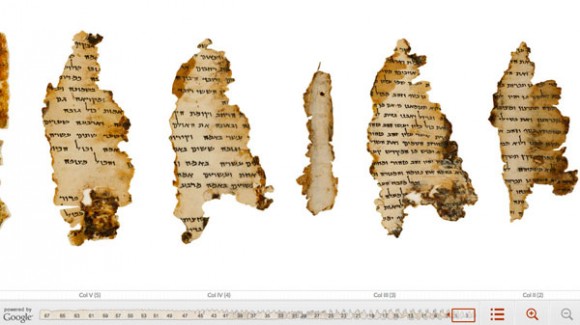
Google says that you can zoom in on the Temple Scroll and see what the animal skin that the text is written on looks like. The Great Isaiah Scroll can be read chapter and verse. The Hebrew text is also translated into English when clicked. The scrolls went online via a partnership between Google and The Israel Museum, Jerusalem.
---
Friday, September 23. 2011
Amazon Kindle books now available in public libraries
Via myce
---
Amazon has struck a deal with 11,000 U.S. libraries that lets Kindle owners borrow ebooks from the increasingly high-tech institutions. The company said Kindle books accessed through this method will boast a suite of social networking support, including Facebook and Twitter. Additionally, Amazon’s own Whispersync app is supported – which means benefits readers previously needed to scuff up books to enjoy, such as bookmarking and highlighting important passages, are freely available.
“Starting today, millions of Kindle customers can borrow Kindle books from their local libraries,” said Jay Marine, Amazon Kindle director. Marine called libraries “a critical part of our communities” and touted the announcement as an important step in bridging an ever-widening gap between the old and the new.
According to Amazon, the process itself is quick and easy.
Members whose local libraries include the online OverDrive service can visit their official sites and select a title for download. Both an Amazon.com account and active library card are required. Transactions are completed over a Wi-Fi connection or USB transfer. Those without a Kindle can still take part in the program by downloading the company’s free Kindle app on a bevy of other devices, including iPad, BlackBerry and the PC Kindle Cloud Reader.
The closure of Borders stores across the country and the growing popularity of digital media consumption among e-reader and tablet owners may not spell utter doom for paper-bound books, but the convenience of downloading them from your home into a single device is hard to ignore. Amazon’s agreement with libraries proves as much.
The tough part now is getting more people to actually read. Sadly, there’s no app for that.
Thursday, September 22. 2011
Dr. Watson - Come Here - I Need You
Via big think
By Dominic Basulto
-----

The next time you go to the doctor, you may be dealing with a supercomputer rather than a human. Watson, the groundbreaking artificial intelligence machine from IBM that took on chess champions and Jeopardy! contestants alike, is about to get its first real-world application in the healthcare sector. In partnership with health benefits company WellPoint, Watson will soon be diagnosing medical cases – and not just the everyday cases, either. The vision is for Watson to be working hand-in-surgical-glove with oncologists to diagnose and treat cancer in patients.
The WellPoint clinical trial, which could roll out as early as 2012, is
exciting proof that supercomputing intelligence, when properly
harnessed, can lead to revolutionary breakthroughs in complex fields
like medicine. At a time when talk about reforming the healthcare system
is primarily about the creation of digital health records, the
integration of Watson into the healthcare industry could really shake
things up. By some accounts, Watson
is able to process as many as 200 million pages of medical information
in seconds – giving it a number-crunching head start on doctors for
diagnosing cases. In one test case cited by WellPoint, Watson was able
to diagnose a rare form of an illness within seconds – a case that had
left doctors baffled.
While having super-knowledgeable medical experts on call is exciting, it also raises several thorny issues. At what point – if ever - would you ask for a “second opinion” on your medical condition from a human doctor? Will “Watson” ever be included in the names of physicians included in your HMO listings? And, perhaps most importantly, can supercomputers ever provide the type of bedside manner that we are accustomed to in our human doctors?
This last question has attracted much attention from medical practitioners and health industry thought leaders alike. Abraham Verghese,
a professor at the Stanford University School of Medicine as well as
bestselling author, has been particularly outspoken about the inability
of computers to provide the type of medical handholding that we are used to from human doctors.
Verghese claims that the steady digitization of records and clinical
data is reducing every patient to an "iPatient" – simply a set of
digital 1’s and 0’s that can be calculated, crunched, and computed.
Forget whether androids dream of digital sheep – can they take a digital Hippocratic Oath?
Given that the cost of healthcare is simply too high, as a society we will need to accept some compromises. Once the healthcare industry is fully digitized, supercomputers like Watson could result in a more cost-effective way to sift through the ever-growing amount of medical information and provide real-time medical analysis that could save lives. If Watson also results in a significant improvement in patient treatment as well, it’s clear that the world of medicine will never be the same again. Right now, IBM envisions Watson supplementing – not actually replacing - doctors. But the time is coming when nurses across the nation will be saying, “Watson -- Come Here –- I Need You,” instead of turning to doctors whenever they need a sophisticated medical evaluation of a patient.
Tuesday, September 20. 2011
Google offers Ice Cream Sandwich guidance to Android app devs
The next major version of Google's Android platform, codenamed Ice Cream Sandwich (ICS), is expected to reach the market in October or November. ICS is expected to bring some significant changes to Android because it will unify Google's tablet and phone variants into a single environment.
Although the SDK is not available yet, Google has published some technical guidance to help third-party application developers start preparing for the ICS transition. An entry posted this week on the Android developer blog describes some steps that developers can take to better accommodate the breadth of screen sizes supported by ICS.
The documentation also provides some insight into how several elements of the Honeycomb user interface could be translated to phone-sized screens in ICS. For example, it includes mockups that show the distinctive Honeycomb action bar on a tablet and a phone. It's not clear, however, if the mockups accurately depict the user experience that will be delivered in ICS.
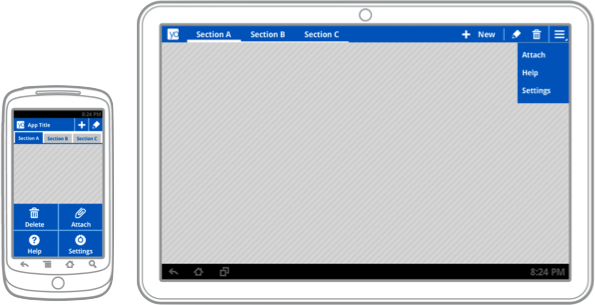
This seems to suggest that tablet user interfaces developed with standard Honeycomb APIs will largely work on phones in ICS without requiring much modification by third-party developers. That's good news, especially if it ends up being equally true the other way, which would allow phone applications built for ICS to look and feel more native on tablet devices. Google's existing Fragments framework will also help simplify interface scalability by making it easy to transition data-driven applications between single-pane to multi-pane layouts.
Developers who use Fragments and stick to the standard Honeycomb user interface components are on the right track for the upcoming ICS release, but developers who have built more complicated tablet-specific user interfaces or haven't stayed within the boundaries imposed by the documented APIs might face some challenges.
Honeycomb applications that were designed only for the tablet screen size might not scale down correctly on phones. That's a problem, because Android's versioning model doesn't prevent old applications from running on devices with new versions of the operating system—it's going to be possible for users to install Honeycomb tablet applications on ICS phones, even in cases where the result is going to be a very broken application.
In cases where third-party developers can't adapt their tablet software to work well at phone sizes, Google suggests changing the application manifest file to block the application from being installed on devices with small screens.
Another challenge is the large body of legacy devices that aren't going to be updated to ICS. Developers who want to reach the largest possible audience will have to refrain from using the new APIs, which means that it will be harder for them to take advantage of the platform's increasingly sophisticated capabilities for scaling across different screen sizes.
Google has already partially addressed this issue by backporting the Fragments framework and making it available as a static library for older versions of the operating system. It might be beneficial for them to go a step further and do the same with the Action Bar and other critical user interface components that will be designed to scale seamlessly in ICS.
It's going to take some time for the Android application ecosystem to sort all of this out after ICS is released, but Google's approach seems reasonably practical. In theory, developers who are solely targeting ICS APIs might not have to make a significant development investment to get their application working well across tablet and phone form factors.
Monday, September 19. 2011
UNIVAC: the troubled life of America's first computer
Via ars technica
By Matthew Lasar
-----
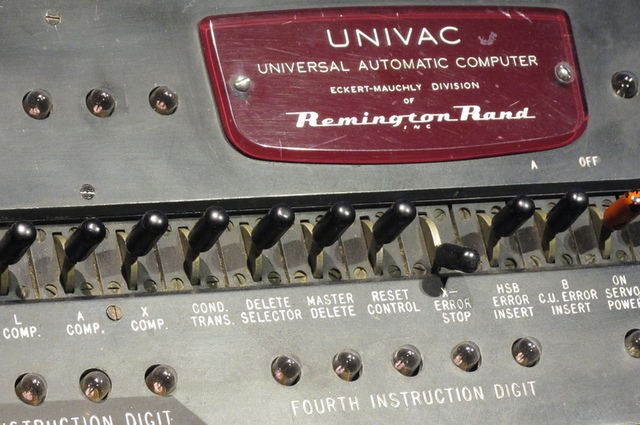
It was November 4, 1952, and Americans huddled in their living rooms to follow the results of the Presidential race between General Dwight David Eisenhower and Adlai Stevenson, Governor of Illinois. We like to think that our time is a unique moment of technological change. But the consumers observing this election represented an unprecedented generation of early adopters, who watched rather than listened to the race on the radio. By that year they had bought and installed in their homes about 21 million copies of a device called the television—about seven times the number that existed just three years earlier.
On that night they witnessed the birth of an even newer technology—a machine that could predict the election's results. Sitting next to the desk of CBS Anchor Walter Cronkite was a mockup of a huge gadget called a UNIVAC (UNIVersal Automatic Computer), which Cronkite explained would augur the contest. J. Presper Eckert, the UNIVAC's inventor, stood next to the device and explained its workings. The woman who actually programmed the mainframe, Navy mathematician Grace Murray Hopper was nowhere to be seen; for days her team had input voting statistics from earlier elections, then wrote the code that would allow the calculator to extrapolate the contest based on previous races.
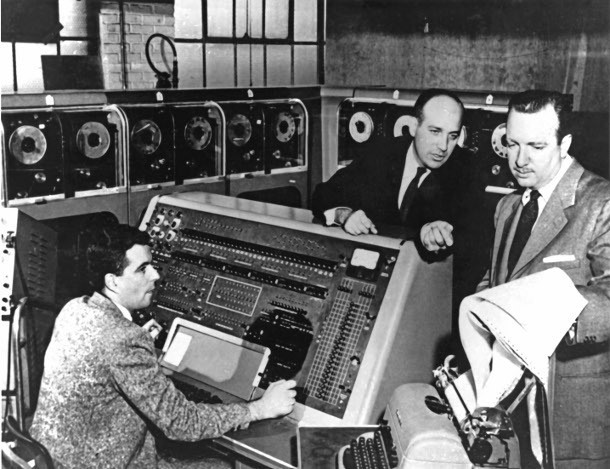
J. Presper Eckert and CBS's Walter Cronkite pondering the UNIVAC on election night, 1952.
To the disquietude of national pollsters expecting a Stevenson victory, Hopper's UNIVAC group predicted a huge landslide for Eisenhower, and with only five percent of the results. CBS executives didn't know what to make of this bold finding. "We saw [UNIVAC] as an added feature to our coverage that could be very interesting in the future," Cronkite later recalled. "But I don't think that we felt the computer would become predominant in our coverage in any way."
And so CBS told its audience that UNIVAC only foresaw a close race. At the end of the evening, when it was clear that UNIVAC's actual findings were spot on, a spokesperson for the company that made the machine was allowed to disclose the truth—that the real prediction had been squelched.
"The uncanny accuracy of UNIVAC's prediction during a major televised event sent shock waves across through the nation," notes historian Kurt W. Beyer, author of Grace Hopper and the Invention of the Information Age. "In the months that followed, 'UNIVAC' gradually became the generic term for a computer."
That's putting it mildly. By the late 1950s the UNIVAC and its cousin, the ENIAC, had inspired a generic sobriquet for anyone with computational prowess—a "BRAINIAC." The term became so embedded in American culture that to this day your typical computer literacy quiz includes the following multiple choice poser:
Which was not an early mainframe computer?
- ENIAC
- UNIVAC
- BRAINIAC
But the fact that this question is even posed is testimony to the other key component of UNIVAC's history—its famous trajectory was cut short by a corporation with a much larger shadow: IBM. The turbulent life of UNIVAC offers interesting lessons for developers and entrepreneurs in our time.
The machines and their teams
During the Second World War, two teams in the United States were deployed to improve the calculations necessary for artillery firing and strategic bombing. Hopper worked with Harvard mathematician Howard Aiken, whose Mark I computer performed computations for the Navy. John Mauchly and J. Presper Eckert's Electronic and Numerical Integrator and Computer (ENIAC) rolled out rocket firing tables for the Army.
While both groups served extraordinarily during the war, their leaders could not have thought about these devices more differently. Aiken viewed them as scientific tools. Mauchly saw their potential as commercial instruments.
After the conflict, Aiken obstinately lobbied against the commercialization of computing, inveighing against the "foolishness with Eckert and Mauchly," at computer conferences. Perhaps there was a need for five or six machines in the country, he told associates; no more. But Aiken's assistant Hopper was fascinated by the duo—the former a graduate student and the latter a professor of electronics.
Eckert was "looking way ahead," Hopper recalled. "Even though he was a college professor he was visualizing the use of these computers in the business and industrial area." The University of Pennsylvania sided with Aiken. The college offered Eckert and Mauchly tenured positions, but only on the condition that they sign patent releases for all their work. Both inventors resigned from the campus and in the spring of 1946 formed the Electronic Control Company, which eventually became the Eckert-Mauchly Computer Corporation.
Over the course of five years, the two developers rethought everything associated with computational machines. The result was a device that went way beyond the age of punch card calculators associated with IBM devices. The UNIVAC, unveiled in 1951, was the fruit of this effort.
"No one who saw a UNIVAC failed to see how much it differed from existing calculators and punched card equipment," writes historian Paul E. Ceruzzi:
It used vacuum tubes—thousands of them. It stored data on tape, not cards. It was a large and expensive system, not a collection of different devices. The biggest difference was its internal design, not visible to the casual observer. The UNIVAC was a "stored program" computer, one of the first. More than anything else, that made it different from the machines it was designed to replace.
These characteristics would enable the UNIVAC to perform thousands more operations per second than its closest rival, the Harvard Mark II. And its adaptation of the entertainment industry's new tool—magnetic recording tape—would allow it to store vastly more data. UNIVAC was quickly picked up by the US Census Bureau in a $300,000 contract, which was followed by another deal via the National Bureau of Standards. Soon a racetrack betting odds calculator company called American Totalisator signed on, purchasing a 40 percent interest in the company.
You could see and hold it
But Eckert-Mauchly could not handle this volume of work on its own. Its principals drastically underbid on key contracts. After a plane crash killed the corporation's board president, the inventors and Totalisor clashed over the viability of the project. The duo then went to IBM for backing and met with Thomas Watson Junior and Senior, but could not convince the elder executive of the UNIVAC's viability.
"Having built his career on punch cards," Watson Jr. later reflected, "Dad distrusted magnetic tape instinctively. On a punch card, you had a piece of information that was permanent. You could see it and hold it in your hand.... But with magnetic tape, your data were stored invisibly on a medium that was designed to be erased and reused."
So EMCC turned to its second choice—the Remington Rand office equipment company, whose founder James Rand expressed outrage when he saw a reworked IBM typewriter rather than a Remington hooked up to the UNIVAC. "Take that label off that machine!" Rand declared on his first visit to an EMCC laboratory. "I don't want it seen in here!"
The tenderness over an IBM logo aside, Remington Rand brought an important innovation to the UNIVAC—television advertisements. The longer infomercials came complete with symphony orchestra introductions and historical progress timelines that began with the Egyptian Sphinx. The shorter ones extolled the role that UNIVAC was playing in weather prediction. "Today UNIVAC is saving time and increasing efficiency for science, industry, business, and government," one ad concluded.
A Remington Rand UNIVAC commercial.
But while that was certainly true about what the machine did for its clients, historian Beyer notes that it didn't extend to Remington's management of EMCC. Most of the office company's top staff, like its founder, didn't understand the device, and related more to punch card machines. The man put in direct charge of EMCC, former Manhattan Project director Leslie Groves, tossed Mauchly to the sales department when he flunked a company security clearance test (apparently he had attended some Communist Party meetings in the 1930s).
On top of that, new management did not sympathize with EMCC's female programmers, among them Grace Hopper, who by 1952 had written the UNIVAC's first software compiler. "There were not the same opportunities for women in larger corporations like Remington Rand," she later reflected. "They were older companies, and the jobs had been stereotyped."
Then there was Groves' marketing strategy for the UNIVAC, which amounted to selling less of the devices, even as they were being hawked on TV as exemplars of technological progress. He ordered a fifty percent annual production quota drop. "With such low sales expectations, there was little incentive to educate Remington Rand's sizeable sales force about the new technology," Beyer explains.
The biggest blow, however, came when IBM began to rethink its aversion to magnetic mainframe storage.
Left in the dust
Despite Remington/EMCC's internal chaos, interest in the UNIVAC exploded after the 1952 CBS demonstration. This created more problems. Hopper's programming staff was now besieged with attractive offers from companies using IBM gear, creating a brainiac drain within EMCC itself. "Some members of Dr. Grace Hopper's staff have already left for positions with users of IBM equipment," Mauchly noted in a memo, "and those of her staff who still remain are now expecting attractive offers from outside sources."
Customer service and support became more and more of a challenge. Still, the UNIVAC was highly competitive with IBM equipment. The question was whether EMCC could beat Big Blue in government contract bidding, specifically for the Semi-Automatic Ground Environment (SAGE) defense communications network.
The SAGE project amounted to an early-warning radar system designed to pick up enemy bomber activity around the nation's borders. It was the brainchild of Jay Forrester, director of MIT's Sernomechanisms Laboratory, and central to the idea was a network of digital computers to integrate the network, dubbed "Project Whirlwind." In three years Forrester's team had pioneered real-time, high-capacity access memory for the mainframes. The government now offered a contract to build 50 Whirlwind computers. IBM quickly rallied its forces for the contest.
"I thought it was absolutely essential to IBM's future that we win it," Thomas Watson Jr., who had none of Senior's allergies to digital computing, later explained. "The company that built those computers was going to be way ahead of the game, because it would learn the secrets of mass production."
Forrester gave the matter some thought. Remington Rand had UNIVAC. And it had the prestige of Manhattan Project Director Leslie Groves. But Remington did not have IBM's scale of operation or its production capacity. Indeed, under Groves' direction, it had scaled that capacity down. In 1953, the government offered the contract to IBM. Historian Beyer explains the consequences of this decision:
Not only did IBM take away knowledge about random-access magnetic core memory; they also learned how the Whirlwind team had pushed the technological envelope in a number of other areas. Forrester's staff had figured out a variety of ways to lower the frequency of vacuum-tube failure, thus increasing system reliability. Cathode-ray-tube displays were ingeniously employed to display processed information, index registers made programming easier, and real-time information from radar sensors could be processed without the need for a slow input medium such as punch cards.
IBM quickly integrated these discoveries into its next rollout of commercial computers. The market loved them and ordered thousands. "In a little over a year we started delivering those redesigned computers," Watson Jr. later boasted. "They made the UNIVAC obsolete and we soon left Remington Rand in the dust."
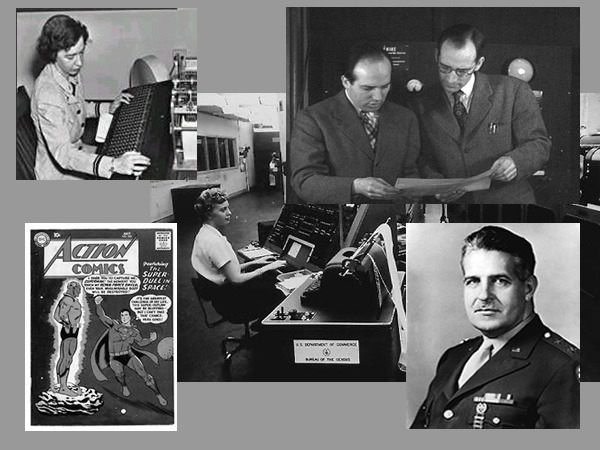
The UNIVAC universe of the 1950s—clockwise from top left: UNIVAC mathematician and programmer Grace Hopper; John W. Mauchly and John Presper Eckert; General Leslie Groves of Remington Rand; DC Comics' Brainiac confronting Superman in 1959; a Department of Commerce UNIVAC in the center.
Aftermath
Sensing the dust around it, in 1955 Remington merged with the Sperry Corporation and became Sperry Rand. No less than General Douglas MacArthur ran the new entity. This gave the UNIVAC a new lease on digital life, but one that operated in the shadow of the company that had once sworn that it would stick to punch tape: IBM.
In the meantime, a slew of firms jumped into the high-speed computing business, among them RCA, National Cash Register, General Electric, and Honeywell. "IBM and the Seven Dwarfs," they were dubbed. UNIVAC was now a dwarf.
Grace Hopper continued her work. She became an advocate of the assumption inherent in her UNIVAC compiler which she called "automatic" computing—the notion that programs should emphasize simple English words. Her compiler, later called FLOW-MATIC, understood 20 words.
Her contemporaries patiently informed her that this number was enough. Hopper "was told very quickly that [she] couldn't do this because computers didn't understand English," she later noted. Happily, she did not believe this to be true, and advised a team that developed the COBOL programming language, which she championed and furthered through the 1960s and 1970s. US Navy Rear-Admiral Grace Murray Hopper died in 1992.
Having fattened IBM on government grants for decades, the Department of Justice launched an antitrust suit against the corporation in 1969. This initiative was suddenly withdrawn by the Reagan administration in 1982—as the company once again jolted the industry by jumping into the PC market.
As for UNIVAC, its complex birth 60 years ago remains the moment when we discovered that computers were going to be part of our lives—that they were going to become integral our work and collective imagination. It was also a moment when information systems developers and entrepreneurs learned that innovation and genius are not always a match for influence and organizational scale.
"Howard Aiken was wrong," historian Paul Cerruzi wrote in 2000. "There turned out to be a market for millions of electronic digital computers by the 1990s." Their emergence awaited advances in solid state physics. Nonetheless, "the nearly ubiquitous computers of the 1990s are direct descendants of what Eckert and Mauchly hoped to commercialize in the late 1940s."
Further reading
Most of the material in this essay comes from Kurt W. Beyer's must-read book, Grace Hopper and the Invention of the Information Age (MIT Press). Also essential is Paul E. Ceruzzi's History of Modern Computing.
Quicksearch
Popular Entries
- The great Ars Android interface shootout (130673)
- Norton cyber crime study offers striking revenue loss statistics (100894)
- MeCam $49 flying camera concept follows you around, streams video to your phone (99679)
- Norton cyber crime study offers striking revenue loss statistics (57123)
- The PC inside your phone: A guide to the system-on-a-chip (56965)
